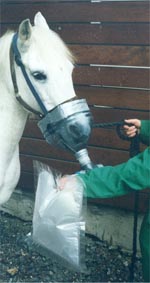The possible causes of dog breath
Published: 22 March 2004
If man's best friend has bad breath, it may be a sign that he needs more than just a scale and polish according to researchers at the University of Glasgow
If your four-legged best friend has dog breath it may be a sign that he needs more than a scale and polish. Analysing breath samples from dogs and other pets could provide vital clues about the animal's state of health, according to researchers at the University of Glasgow.
For centuries, doctors dealing with human patients have known that certain odours on the breath are a good indicator of a particular disease - such as the pear drops smell on the exhaled air from a diabetic patient. But normal human breath can contain at least 3, 000 different gases and changes in the concentration of some of these components may be useful in the diagnosis of a wide range of disease conditions.
The technology is now available to accurately analyse this complex mixture in the laboratory and these methods are likely to be especially useful in the veterinary field, according to Dr Cathy Wyse and her colleagues at the Institute of Comparative Medicine, writing in this week's Veterinary Record.
'The greatest advantage of the breath test over other diagnostic methods is the ease with which it can be carried out ヨ breath samples can be collected anywhere and by people with no medical training,' explains Dr Wyse. 'The non-invasive nature of the breath test makes it a particularly attractive diagnostic method in veterinary medicine.'
Many current methods for diagnosing disease in animals are stressful for the animal, such as taking blood samples or taking skin biopsies. Other methods such as x-rays and ultrasound will often require the animal to face the risks involved with a general anaesthetic. But to collect a breath sample a dog or horse need only wear a face mask for a few minutes, while cats and smaller animals can be briefly put inside a closed chamber.
Media Relations Office (media@gla.ac.uk)
For more details please conact the University Press Officer Mike Findlay on 0141 330-8593, or email: m.findlay@admin.gla.ac.uk, or Dr Cathy Wyse on 0141 330-5999 or email: cwyse9@aol.com.
First published: 22 March 2004
<< March


